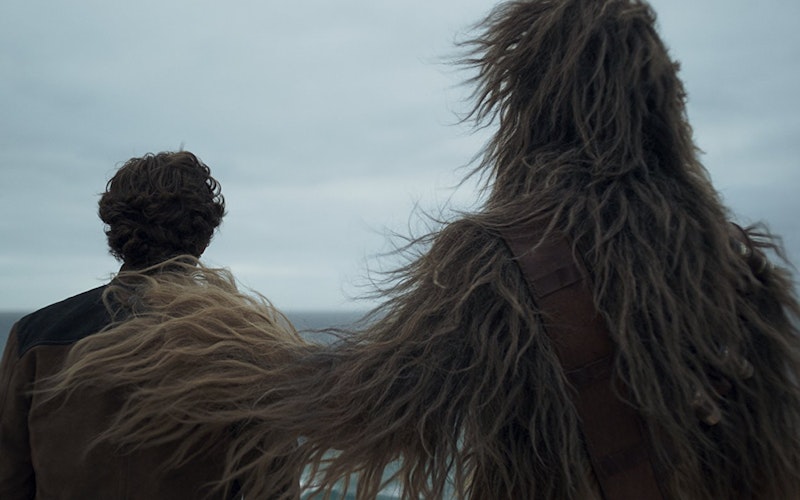
Movies
When Han Met Chewie
Editor’s note: While free of major spoilers, this post does describe scenes from Solo: A Star Wars Story in detail.
People don’t work well alone, no matter how much they may claim that’s the case. In Solo: A Star Wars Story, Han Solo (Alden Ehrenreich) claims to be a loner, but everything he does in the film is in pursuit of reuniting with an old girlfriend and finding a community to which he can belong. He never admits it and his name denies it, but Han doesn’t like being alone.
Fortunately for Han, early on in Solo he’s dumped into a mud pit with an angry Wookiee named Chewbacca (Joonas Suotamo)—a moment that will spark the decades-long partnership we already know from a number of other Star Wars films. For me, the sequence also illustrated a point from C.S. Lewis’ The Four Loves about the uniqueness of true friendship.
The mud-pit scene is an odd start to a friendship: both are chained together as prisoners of the Imperial army, covered in sludge, and miserable. Han is confused and Chewbacca is angry enough to kill. Han realizes that he’s going to die unless he convinces Chewbacca otherwise, so he tries talking to him in his own language, reaching out on his own terms. Han’s halting attempts to speak Wookiee—and Chewbacca’s surprise and relief to hear a familiar language— brought to mind a section from The Four Loves, in which Lewis describes people discovering the common ground that leads to friendship: “What! You too? I thought that no one but myself…”
As Solo proceeds, the bulk of the plot revolves around various cons and heists, yet the movie’s true concern is the mythology behind the character of Han Solo. We already know who Han is thanks to the previous Star Wars films. We’ve heard bits and pieces about his background: how he acquired his ship, the Millennium Falcon (gambling); how he became a smuggler (booted from the Imperial army for insubordination); what his reputation is (disreputable). But we haven’t seen any of those details, and the movie is eager to show us, beat by beat: this is how Han got his blaster and his ship; this is how he met Chewbacca; this is the Kessel run and how they managed to do it in 12 parsecs. Pieces of Han’s past are woven into the film as explanations for everything he’s said and done in the main Star Wars films. There’s no room left for mystery; everything must be shown, set to leitmotifs from John Williams’ original score. It feels as though the movie is delivering swift nudges to the ribs of the audience every time something familiar is brought up.
He never admits it and his name denies it, but Han doesn’t like being alone.
Strangely enough, for a movie that treats so much of its subject matter like sacred artifacts, the matter of Han Solo’s name is covered swiftly and then never discussed again. In a 30-second scene, an Imperial recruiter notes that Han has no last name, no family, no home, then pronounces him “Han Solo” and sends him on his merry way. The scene is also contradictory to the rest of the film; Han is never really alone, or even lonely, especially once he meets Chewbacca. In the world’s strangest “meet-cute,” Han is literally chained to Chewbacca. Even after they work together to escape from the pit, they remain tethered by the iron. They are inseparable by necessity at first, but as they get to know each other, they begin to respect each other, to work together as a team.
In The Four Loves, Lewis proposes the following categories: affection, friendship, eros (sexual love), and agape (unconditional love). All are considered through the lens of Christian spirituality. It’s possible to see most of these in Solo, but the most important is friendship, understood through the partnership and eventual camaraderie of Han and Chewbacca. Lewis describes friendship as unique among the loves because it appears to be given purely by choice. (Affection is a love for the people we’re placed with, such as family or colleagues; eros is subject to romantic attraction, which cannot be consciously controlled; agape is required of all Christians to be given freely to everyone else.) Lewis describes friendship as “the instrument by which God reveals to each the beauties of all the others.” In this scenario, no one person is any greater than another, but each one is uniquely created by God. Friendship draws these varieties out into the open where they can be celebrated.
Friendship is the “least natural of loves,” according to Lewis, because it is “the least … necessary” to survival. Indeed, one character who becomes something of a mentor to Han tells him to never trust anyone, because trust means vulnerability, and vulnerability means exposure to betrayal. Despite the fact that this advice is repeated throughout the movie, Han still trusts one other person in the universe: Chewbacca.
Because Han trusts Chewbacca, and vice versa, the two make a good team. Both characters are capable of taking care of themselves, but they work best together—Han doing the talking, Chewbacca providing the muscle and technical skill, until eventually the two appear as an inseparable unit. The clearest indication of their partnership appears in the movie’s final shot: of the two of them simultaneously shifting the lever to push the Millennium Falcon into hyperdrive. Each could do it alone, but they choose to go forward together, in friendship.
Topics: Movies